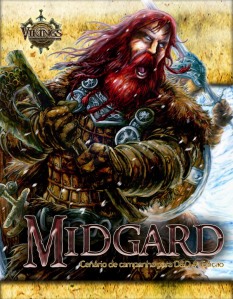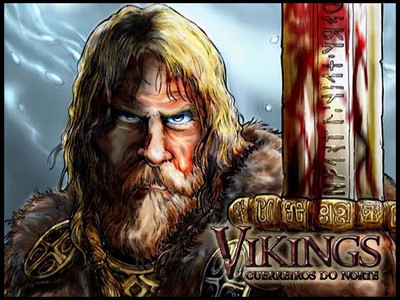Heilsa! This is not a new post. It has already been published on some sites out there, such as Paragons, but I thought it wise to leave it here as well, on the official site of the Vikings line. This is a review of the first book in the series, in its second edition, Midgard!
And finally out!
I received my box a while ago, but due to the hustle and bustle of the beginning of the year, I can't talk about it. Now that I've read and reread it, I feel a little more comfortable talking about it. The box is really nice and knowing that I will be able to store my other books from the Vikings series in it makes me even more satisfied. The map, apart from that shine that doesn't let me read the names, is a very good resource to use in the game. As Cuty said, it's expected that that shine will go away with time, but I'm not complaining, it was a great move.
I've never written a review, so I prefer not to call this one, it's more of a reflection on the product. Reviews are often unbiased, or at least they should be, and I'm a bit biased along those lines. Without further ado, let's get to the book!

The art that illustrates the cover, by the excellent Flávio Augusto Ribeiro, is the same as presented in its first edition. This time, however, we have a different framing and a slightly rougher and more aggressive look, which I liked a lot. The book's Introduction has the comic book that tells Sven's search for the runes, the most important event within the scenario, responsible for uniting all nine worlds of the Norse universe.
As we know, Vikings draws from a very important source for understanding Norse mythology, the Edda. This effort is made clear in Chapter One, History, which beautifully portrays the legends recounted in Snorri Sturluson's Edda. We are presented with already famous stories, such as the origin of beings from Ymir, the war between the Aesir and Vanir and the emergence of dwarves and men. But not only known legends make Vikings, the best part of this chapter is explaining how Loki tricked Odin to obtain the secret of the location of the Runes that separated the eight worlds of Midgard and how he later used greed. of Sven to open them and thus make the nine worlds one.
A bug has also been fixed in the new edition, regarding Fenrir's condition. After having suffered a withering blow from the hands of Sven, who was seeking his surrender after having made the mistake of opening the runes, the wolf was gone, never to be seen again. In this new issue we see the gods' final attempt to arrest the indomitable beast, using Gleipnir and the price that was charged for it, the hand of Tyr, the god of war and courage.
Chapter Two – Characters – introduces the main peoples that inhabit Midgard. Humans are divided into three distinct ethnicities: the rugged Norske, the audacious Svíar, and the proud Dane. As nonhuman races we have the warlike dwarves of Nidavellir, deep in their realm in the Scandinavian Alps. The clever little Köbolts, who are not a united people, but are mirrored everywhere. The immense jotunym, descendants of frost giants who did not develop to their full potential and, therefore, were banished from living with their ancestors. And finally, the Vaniryan recluses, who have the blood of the Vanir gods in their veins.
All of these races were present in first edition Midgard, but here they get their rules and details for fourth edition D&D, with fair modifiers and relevant Racial Powers. I was a little apprehensive before reading this part dedicated to races, because I thought I would see Dragonborn, Tieflin and Eladrin walking among the vikings. It was a pleasant surprise to see these names appearing only in a paragraph, where it is explained that they are not compatible with the scenario, but if the narrator wants to put it, it must be realized that they came from “outside”.
The chapter follows with a brief description of the most credible classes for the scenario, exemplifying their role within the game. I find this kind of information very useful, even if only in a quick brushstroke as presented. It makes life a lot easier for the narrator, by pointing out which classes are available within the game, also helping to make the group organize itself more cohesively.
Next we have the two main highlights of the chapter: the Rune Caster and the Berserker. The first, the main spellcasting class of the scenario, is presented from levels 1 to 30, with a very varied list of powers that portray the Nordic environment well. From the names to the short descriptions, care has been taken to invoke an aura of power in this new and, in my view, very well-built class. The Berserker, contrary to what one might imagine, is not just an “angriest barbarian”, but a warrior's path to follow! This may be strange to some people, but it's worth explaining my point of view.
Within Norse cosmology there are two races of gods, the Aesir and the Vanir. The former are more human gods, so to speak, who embody aspects common to all of us, such as strength, poetry, battle, war, courage, family, etc. The Vanirs, on the other hand, embody natural elements, such as nature, the sun, the moon, the weather, the sea and so on. There are some exceptions to this “rule”, like Freyja, who has a very human profile with her representation of female beauty, as well as Freyr of male beauty. Berserkers enter a state of rage because they are brought to him by Odin, lord of the gods and chief Aesir. The barbarians of fourth edition D&D have the "Primitive" as their source of power, something that is completely reminiscent of the Vanirs. That's why I think the idea of making the berserker as a warrior's path was extremely right.
We also have the Exemplary Trails, following the same standard of care with balance. They are the Prestige Classes that were introduced in the first edition of Midgard, with a new treatment to make them compatible. The only thing I missed in this regard was a list of what other Exemplary Paths would be suitable for the setting. I refer to the one that has been presented in published books. It would help a lot, just like the base classes. Finally, a short list of talents highlighting the divine ones, which were very interesting.
I wonder what Epic Destinies await the warriors of the north…
Chapter 3 – The Viking Life – is one of the tastiest to read. He takes care of all the details that will bring real life and breath to your game. We understand the functioning of society divided into castes and how Renome can help in this mobility that is only possible through deeds. Clothing, way of life and family are presented in such a way that one thinks twice before calling the northern peoples barbarians, which is only clearer when reading about the code of conduct adopted by the warriors. They might not be 5th dan samurai of any jutsu… But honor is worth a lot too. So much so that single combat duels are not rare to happen, to solve some problem that diplomacy can't handle.
The runic alphabet, so important and mystical, and a calendar add an extra touch to any setting. Making it possible for the Storyteller to better blend these elements into their game, without worrying so much about looking outside. The construction of the six months of short days and the six months without a night became very interesting. Referring to the case of the Brisingamem necklace of the goddess Freyja, which passes in her possession in the six months without night and in Loki's possession in the six months of short days, representing the sadness of the goddess who separates herself from her most precious possession.
Many other details are discussed in the chapter, such as a basic explanation of what Viking houses, cities and even funerals look like. It would not fit here to quote all this, since the book does the job very well.
In Chapter 4 – The Nine Worlds – we have a brief description of the environments that joined Midgard when Sven opened the runes that sealed the passages. Two of them have already been described in a first edition supplement, Kingdoms of Stone, which is also expected to get a new version, with its rules adapted for 4th edition D&D and updated information. As far as Midgard is concerned, we are introduced to some useful information such as the prevailing climate of the northern lands and the dangers that await those who dare to defy the cold and snow. Cities, strongholds and gatherings are further detailed, setting the stage for describing the three main areas of influence of the Viking people.
We start with Danemark, the home of the Danes. The only land to be considered a kingdom, ruled by the imposing lineage of the Volsung, direct descendants of Odin himself. Although they are a strong kingdom, they are not without problems, and some political intrigue can force men to lay down their weapons and learn that a sharp tongue can be as dangerous as any ax or sword. The cities described have small maps that make it much easier to describe the location and the descriptions contained in the book are also enough for you to create yourself from above, full of hooks and seeds of ideas.
Sverarheim, the home of the Svíar, is a divided land. The warriors must choose which side to take, Sven, who tries to right the mistake he made when opening the runes, or Sigar, who believes in the self-preservation of the Svíar people and thinks it's right to close themselves off from the rest of the world. Svearheim is not a kingdom, like Danemark, but a territory dominated by the Svíar people who elect a great jarl in times of need. A position that Sven once held and that Sigar holds today. As great slave traders, the main travels of the Swar people are aimed at the Finn lands to the east. These captives are sold in all major ports, in and out of Scandinavia, such as Nidaros in Norsklund and Hedeby in Danemark.
Finally, we have the inhospitable Norsklund. Home to the toughest, most irresolute men in all of Midgard. It might have had a brighter future if it weren't for the greed of a certain jarl. It is said that Odin gave the city of Oslo a personal artifact to protect it from all weathers, but when Gunnar orchestrated an invasion of Europe he made use of this gift from the gods. The Mount of Odin, as it was called, has since been lost. Today Norsklund is divided into small towns with little connection to each other. The Scandinavian Alps manage to make traffic through the region even more difficult, and the presence of the dwarves in them seems to have only made matters worse. The only highlight is the city of Nidaros, ruled by Svaran, Dragonclub. It is the last point of civilization facing the north, now inhabited by the frost giants.

The difference in these chapters is in the description of the places where Sven found each of the runes and the dangers he had to overcome to gain access to them. Some serve as great locations for adventures after the opening and others seem to have become real life guzzlers! Not advisable for beginner groups… Really.
At the end of the chapter we have a brief and very useful description of the foreign peoples that populate the rest of Midgard. From Welsh to Arabs, the information is enough to instill curiosity to imagine such an encounter. It is also worth remembering that throughout the entire chapter small text boxes explain historical details of some places, always emphasizing that you should not worry about it, valuing the moment of the game more and less historical fidelity. After all, we want to have fun in the RPG and not narrate a documentary.
The gods are described in Chapter Six very briefly and practically. Although I really like descriptions, I even understand that it wouldn't do to write too much at this point in the book and, moreover, it's a D&D pattern followed since the previous edition. The biggest highlight here is the images, always very well executed, of the great Flávio Augusto Ribeiro.
Next come the monsters! Chapter Seven lists the monsters, present in D&D4th edition releases, that best match the Vikings environment. The creatures in the setting are our familiar ones, such as the Huldre People and the Trollds. They gained new versions, to better support the approach of the new system. The dragon Hrodsorm looks deadlier than ever, and the newest enemy for his warriors is the Draugar, undead in the service of Hel.
The last chapter of the book – Combat and New Rules – deals with new rules systems and some details relevant to the setting. Here we see the usefulness of Renown, which works like the old Action Points, allowing the character to perform actions that would be almost impossible. We also see what are the preparations to be taken when planning a viking invasion, in addition to the most used mass combat tactics. The Targeted Attack, responsible for the amputation of many limbs, is revised and adapted for the 4th edition. I missed the Mass Combat system, but maybe it's possible to use the old one without major trauma. Emphasis is given to the details of the vessels used by the men of the north, with a technical sheet and statistics that greatly facilitate the narrator's life. A topic that pleased me a lot was about equipment typically used by Vikings, which was lacking in the previous edition.
Finally, an appendix with a useful pronunciation guide for players and storytellers, a timeline of the feats of Viking peoples and a glossary with the main names used in the book, for quick reference.
My only complaint about the treatment of the book is some drawings that are cut off at the bottom of the page. It's a personal freshness, but it bothers me to know that the drawing “continues” and is cut at a certain point. Just so they don't say I was just compliments, okay?
Alright, I'll give it a go… This sounded more like an advertisement than a review, but you have to agree with me… A job well done is a job well done!




